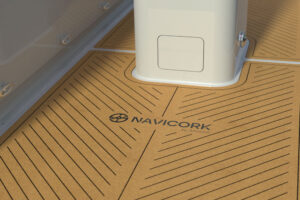Teak has a long-standing tradition in the yacht industry. However, more and more alternatives are coming onto the market, such as cork. This material is suitable for decking, among other uses.
Cork products, like those from the supplier Navicork, can offer both ecological benefits and excellent material properties. The size of the deck coverings can be flexibly adapted, from trailerable boats to superyachts. Thanks to their cork joining system and the way the cork panels are pressed, individual sizes and shapes can be offered.
A teak deck on a yacht can last up to 20 years before it needs to be replaced or repaired, depending on the care and duration of use. However, this length of time is highly dependent on several factors, including frequency of use, exposure to UV radiation, salt water and other environmental conditions, as well as the quality of the original installation and regular maintenance.
Cork decking keeps up with teak

With proper care and use, a cork deck can last just as long as a conventional deck, according to Navicork. Because it is a natural material, the appearance of cork can change over time when exposed to UV light. To mitigate these effects, Navicork cork decking is treated with protective coatings or UV-resistant treatments. However, contact with salt water is not a problem and it will not crack.
It is also easier to sand than teak. Only a thin layer of less than 1/10 mm needs to be sanded off with normal sandpaper – with conventional teak decking, an average of one to two millimetres is sanded off, depending on the condition.
One of cork’s natural advantages is that it is much more environmentally friendly to extract than teak. Cork is the “skin” of the cork oak. No trees are felled or damaged during the extraction process, only their outer bark is removed. The cork oak is the only tree whose outer bark regenerates itself and can be harvested up to 17 times during its approximately 200-year life cycle.



